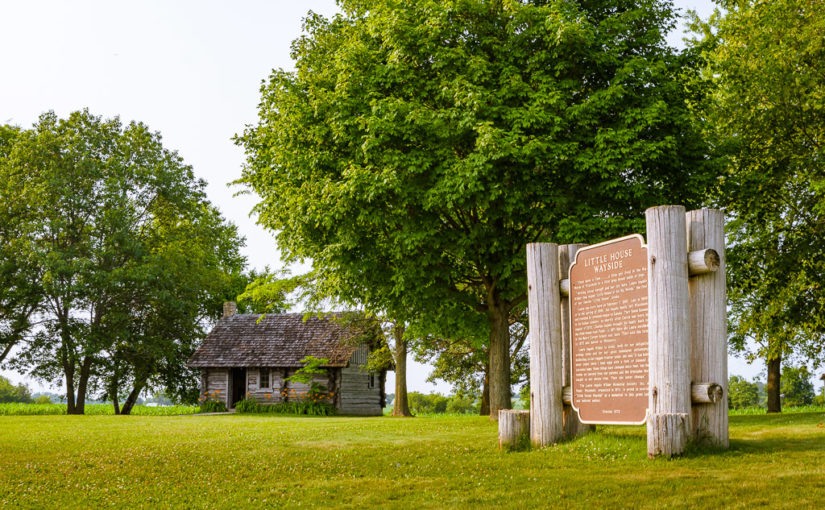Today we got a much later start than I had hoped, but it seems like everything somehow worked out.
We left the Motel 6 in Janesville (they left the light on for us, but we turned it off before we left) right around 11am and headed north (or west…whatever) on I-90 past Madison and Wisconsin Dells on up to the Mississippi River.
The Driftless Area of Wisconsin

We were really impressed with the gorgeous rolling hills around Madison and on up through Wisconsin Dells. Everything everywhere was just wonderfully green and lush, and everyplace seemed very well-manicured and maintained, which is wonderful to see. Lots of times you would see modern industrial and commercial buildings, and sure enough, behind it would be a farm—something that is novel for me to see right next to suburban buildings.

Now once we got further north, the flora seemed to change to having more conifers in the mix and things weren’t quite a lush green anymore—they were more of a California or Rocky Mountain green, but not quite that color. It also got hazier and hazier, and that was likely because smoke was blowing in from forest fires burning all the way up in Canada. What was also strange was that there were huge valleys that would open up, and lots of times you’d even see small mountains that were too small to be considered officially mountains—maybe we could call them “dwarf mountains“. You’d see naked rocks that looked as old as time standing in the middle of a bunch of trees next to the freeway too…something else that I never associated with Wisconsin or Minnesota.


Eventually we passed LaCrosse and went over the Mississippi River into Minnesota on I-90 and US-61, which parallels the Mississippi. US-61 actually follows the Great River all the way into Minneapolis, and there are busy railroads on both sides of the river carrying trains. Many of the trains heading south are all tanker cars, probably full of North Dakota crude oil bound for refineries in Louisiana. All along the river there were heavily-wooded bluffs with dwarf mountains, knolls, knobs, and rock outcroppings breaking up the trees.
Pepin & Little House in the Big Woods

We crossed back into Wisconsin at Wabasha on MN-60/WI-25 to go to Pepin. This is where Laura Ingalls Wilder was born and lived as a little girl, and where she got inspiration to write Little House in the Big Woods. They have a museum there, and about 7 miles out of town there’s a replica log cabin. Pepin from WI-35 seems unremarkable in town, with a few little stores you’d see anywhere else, and a little motel with a campground where we stayed. The biggest attraction on the main street was the Laura Ingalls Wilder Museum. Admission is only $5 and they have plenty of artifacts from the era when Laura and her family lived in Pepin Township, including cook stoves, clothing, tools, a covered wagon, and canoes used to fish on Lake Pepin.

We met Dawn there, along with her mom, Mary, who just retired as the village clerk and was now planning to devote much more time to her position on the board of trustees for the historical society that runs the museum. They just expanded from a small building into two much larger buildings, and were in the midst of reorganizing and remodeling to improve their exhibits. All throughout the museum were artifacts, either with stories behind how they were used by the family, or with quotes from Little House in the Big Woods pointing out where Laura referred to them. There’s a video presentation on the history of Laura’s family in Pepin, along with other history of the area. Mary showed us on a big map from 1877 which lot Charles Ingalls had bought with his brother-in-law near the edge of Pepin Township. She explained how they found the information years ago by putting the word out for property owners to check their title abstracts for Charles Ingalls. She also shared the story of how she and the historical society worked to get grants and raise money for the museum to build a replica log cabin on the site of the old Ingalls farm at a wayside. (In Wisconsin, small roadside parks along highways that we would call rest areas in Ohio are called “waysides”.)

We followed County Road CC out to the Little House Wayside Cabin, built in 1978 just a few hundred feet from where Charles & Caroline Ingalls started their family. The countryside round about the town was incredible! Beautiful farms and woods were all along the winding highway. We saw several farms that looked like they belonged on postcards.
Continue reading RealImaginaryWest Day 2 – Dwarf Mountains, the Great River, and a Little House

